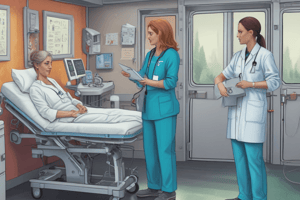Podcast
Questions and Answers
What are the components routinely included in vital signs?
What are the components routinely included in vital signs?
- Temperature, pulse rate, respiratory rate, and blood pressure (correct)
- Temperature, pulse oximetry, respiratory rate, and blood glucose level
- Temperature, pulse rate, blood oxygen level, and blood pressure
- Temperature, pulse rate, oxygen saturation, and blood pressure
Which of the following is a danger in the level of consciousness during a head to toe assessment?
Which of the following is a danger in the level of consciousness during a head to toe assessment?
- Calmness
- Drowsiness
- Restlessness (correct)
- Confusion
What is Battle’s sign associated with during a head to toe assessment?
What is Battle’s sign associated with during a head to toe assessment?
- Facial symmetry
- Tracheal deviation
- Bluish discoloration of the mastoid area (correct)
- Pupils size and reaction to light
What does the assessment of neck in a head to toe examination include?
What does the assessment of neck in a head to toe examination include?
What is assessed during the examination of extremities in a head to toe assessment?
What is assessed during the examination of extremities in a head to toe assessment?
SECONDARY SURVEY Focuses on head to toe ______ for undetected injuries, diagnostic and laboratory testing, splinting of suspected fractures, insertion/ application of monitoring devices (ECG, Electrodes, Arterial Lines or Catheters).
SECONDARY SURVEY Focuses on head to toe ______ for undetected injuries, diagnostic and laboratory testing, splinting of suspected fractures, insertion/ application of monitoring devices (ECG, Electrodes, Arterial Lines or Catheters).
The first step in the primary assessment is to DETERMINE if the patient is CONSCIOUS. If the patient is ______, the primary assessment can be performed at a glance.
The first step in the primary assessment is to DETERMINE if the patient is CONSCIOUS. If the patient is ______, the primary assessment can be performed at a glance.
A patient who is alert and talking indicates that there is breathing and circulation. A ______ patient also indicates that circulation is adequate and enough blood is being circulated to the brain. If, however, the patient is not fully ______, the primary assessment should be proceed step by step.
A patient who is alert and talking indicates that there is breathing and circulation. A ______ patient also indicates that circulation is adequate and enough blood is being circulated to the brain. If, however, the patient is not fully ______, the primary assessment should be proceed step by step.
In serious injured or ill patients, it is recommended to add more two letters to the primary ______: D-disability, and E-expose. D. Airway-Does the patient have an open airway. E. Breathing-Is the patient breathing. F. Circulation-Is circulation in immediate jeopardy. a. Is there a pulse. b. Is there profuse bleeding.
In serious injured or ill patients, it is recommended to add more two letters to the primary ______: D-disability, and E-expose. D. Airway-Does the patient have an open airway. E. Breathing-Is the patient breathing. F. Circulation-Is circulation in immediate jeopardy. a. Is there a pulse. b. Is there profuse bleeding.
PRIMARY ASSESSMENT G.
PRIMARY ASSESSMENT G.
Flashcards are hidden until you start studying




